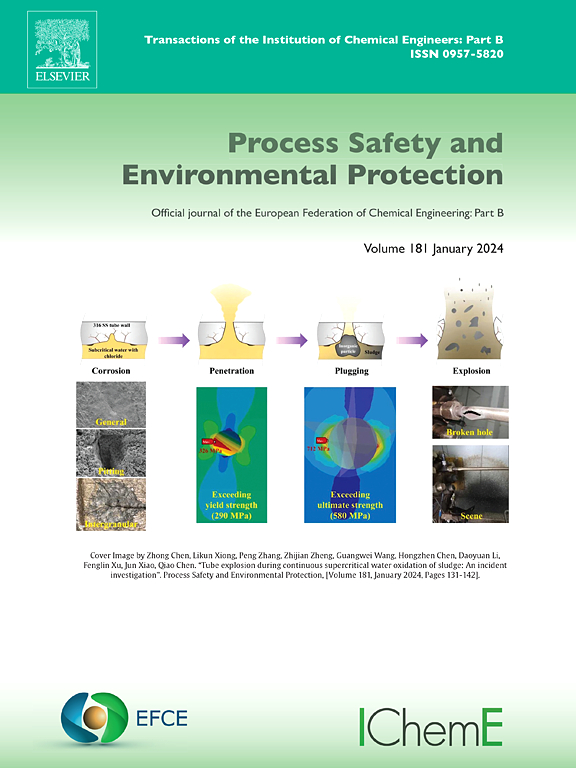煤地下燃烧-气体动力学的官能团驱动调控
IF 6.9
2区 环境科学与生态学
Q1 ENGINEERING, CHEMICAL
引用次数: 0
摘要
地下煤层强化燃烧与原位热能开采相结合是原位化学流态化开采煤炭资源的一种新的范式转换策略。系统研究了在注入强化条件下的燃烧动力学和反应气体演化,为优化这种原位热化学转化过程提供了验证。本研究通过FTIR和TG-FTIR联合分析阐明了煤燃烧的变质依赖性,描绘了不同变质等级煤的官能团演化和气体排放动态。结果表明,煤的变质作用增强,其特征是多取代芳基(2邻H变形)和稳定的OH-π结构的增加,以及活性含氧基团(共轭CO和-COOH)和不对称脂肪链的减少,共同降低了煤的可燃性。燃烧性能指标表明,低变质度煤在较低温度下具有较强的着火性能和燃烧效率,而高变质度煤的可燃性较差,但燃烧速率较高。高变质煤由于不完全氧化表现出较低的CO2排放强度和较高的CO排放强度。燃烧产物的这种差异与高变质阶段完全氧化所需的氧气增加直接相关。CH4排放主要发生在200 ~ 700℃热区,400℃是不同变质程度煤CH4释放强度峰值的临界热分界点。NO是有害气体NOx的主要成分,高变质煤释放的NO较少。着火倾向与-COOH呈线性关系,燃尽效率随3个相邻H变形成比例提高。哦,哦,asym。R₂CH₂和对称。RCH₃共同控制煤燃烧过程中气态物质的体积释放。这些发现为通过战略性地利用煤成熟度的自然变化来优化地下煤燃烧系统提供了科学依据。本文章由计算机程序翻译,如有差异,请以英文原文为准。
Functional group-driven modulation of combustion-gas kinetics in underground coal enhanced combustion
Enhanced combustion coupled with in-situ thermal energy extraction in underground coal seams represents a novel paradigm-shifting strategy for coal resource extraction through in-situ chemical fluidized mining. Systematic investigation into the combustion dynamics and reactive gas evolution under injection-enhanced conditions provides validation for optimizing this in-situ thermo-chemical conversion process. This study elucidates the metamorphic dependence of coal combustion through combined FTIR and TG-FTIR analyses, delineating functional group evolution and gaseous emission dynamics across coals of different metamorphic grades. The results indicate that the intensification of the coal metamorphism, characterized by increased multi-substituted aromatic groups (2 adjacent H deformation) and stable OH-π structures, alongside reduced active oxygen-containing groups (conjugated C![]() O and -COOH) and asymmetric aliphatic chains, collectively diminishes the coal ignitability. Combustion performance indices reveal that low-metamorphic-degree coal exhibits enhanced ignition and combustion efficiency at lower temperatures, whereas high-metamorphic-degree coals demonstrate inferior ignitability but achieve higher combustion rates. Highly metamorphosed coal typically exhibits lower CO2 emission intensity and higher CO emission intensity due to incomplete oxidation. This divergence in combustion products directly correlates with enhanced oxygen demand requirements for complete oxidation at higher metamorphic stages. CH4 emission predominantly occurs within the 200–700℃ thermal regime, with 400°C serving as a critical thermal demarcation point for the peak CH4 release intensity from coals of varying metamorphic degrees. NO is the main component of the harmful gas NOx, and highly metamorphosed coal releases less NO. Ignition propensity demonstrates linear dependence with -COOH, and the burnout efficiency exhibits proportional enhancement of the 3 adjacent H deformation. OH-OH, asym. R₂CH₂, and asym. RCH₃ collectively control the volumetric release of gaseous species during coal combustion. These findings offer a scientific basis for optimizing underground coal combustion systems by strategically utilizing natural variations in coal maturity.
O and -COOH) and asymmetric aliphatic chains, collectively diminishes the coal ignitability. Combustion performance indices reveal that low-metamorphic-degree coal exhibits enhanced ignition and combustion efficiency at lower temperatures, whereas high-metamorphic-degree coals demonstrate inferior ignitability but achieve higher combustion rates. Highly metamorphosed coal typically exhibits lower CO2 emission intensity and higher CO emission intensity due to incomplete oxidation. This divergence in combustion products directly correlates with enhanced oxygen demand requirements for complete oxidation at higher metamorphic stages. CH4 emission predominantly occurs within the 200–700℃ thermal regime, with 400°C serving as a critical thermal demarcation point for the peak CH4 release intensity from coals of varying metamorphic degrees. NO is the main component of the harmful gas NOx, and highly metamorphosed coal releases less NO. Ignition propensity demonstrates linear dependence with -COOH, and the burnout efficiency exhibits proportional enhancement of the 3 adjacent H deformation. OH-OH, asym. R₂CH₂, and asym. RCH₃ collectively control the volumetric release of gaseous species during coal combustion. These findings offer a scientific basis for optimizing underground coal combustion systems by strategically utilizing natural variations in coal maturity.
求助全文
通过发布文献求助,成功后即可免费获取论文全文。
去求助
来源期刊

Process Safety and Environmental Protection
环境科学-工程:化工
CiteScore
11.40
自引率
15.40%
发文量
929
审稿时长
8.0 months
期刊介绍:
The Process Safety and Environmental Protection (PSEP) journal is a leading international publication that focuses on the publication of high-quality, original research papers in the field of engineering, specifically those related to the safety of industrial processes and environmental protection. The journal encourages submissions that present new developments in safety and environmental aspects, particularly those that show how research findings can be applied in process engineering design and practice.
PSEP is particularly interested in research that brings fresh perspectives to established engineering principles, identifies unsolved problems, or suggests directions for future research. The journal also values contributions that push the boundaries of traditional engineering and welcomes multidisciplinary papers.
PSEP's articles are abstracted and indexed by a range of databases and services, which helps to ensure that the journal's research is accessible and recognized in the academic and professional communities. These databases include ANTE, Chemical Abstracts, Chemical Hazards in Industry, Current Contents, Elsevier Engineering Information database, Pascal Francis, Web of Science, Scopus, Engineering Information Database EnCompass LIT (Elsevier), and INSPEC. This wide coverage facilitates the dissemination of the journal's content to a global audience interested in process safety and environmental engineering.
 求助内容:
求助内容: 应助结果提醒方式:
应助结果提醒方式:


